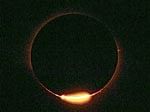
The months of July-August this year are replete with eclipses. While there was a lunar eclipse on July 8, there’s a total solar eclipse tomorrow (July 22) and another lunar eclipse on August 6. Of these, tomorrow’s total solar eclipse will be a spectacular event.
The dramatic daytime darkening of the sunlit sky for a couple of minutes during a total solar eclipse has been recorded for thousands of years. For instance, the total solar eclipse of April 16, 1178 BCE was supposed to have been witnessed by Homer the poet. Chinese and Indian observations also go back millennia while ancient Babylonians knew about the Saros (periodic repetition of eclipse over an 18-year interval).
In a given year, there may be as many as five solar eclipses or as few as two, while at a given spot on earth, a total eclipse would recur every 350 years. The theoretical maximum duration of a total solar eclipse is about seven and a half minutes.
Unusual eclipse
The July 22 eclipse is unusual in the sense that it would last six minutes and forty five seconds, close to the maximum. The average duration is around two to three minutes. The next longest duration will occur only in the year 2132.
Solar eclipse occurs when the moon directly comes between the earth and the sun. It is a remarkable coincidence that the apparent size of the sun and the moon as seen from the earth are the same (about half a degree angle subtended).
The moon has a diameter 400 times smaller than the sun, but it is 400 times nearer, so they appear the same size and the moon is just able to cover the sun’s bright disc during the eclipse. Although there are over 160 moons orbiting other planets of the solar system, this coincidence is unique for only the earth-moon system, so that the total solar eclipse is a unique spectacle for earthlings only.
However, because of tidal drag, the moon is receding from the earth at three centimetres a year, so that in 600 million years or so, our descendants would no longer be able to witness such an event. Tidal locking implies that the moon’s rotational period and its orbital period around the earth is the same (about a month). Another coincidence is that the sun’s average rotational period is also around a month. Records of ancient eclipses also show that the earth day was slightly shorter then and tidal drag increased the rotation period.
What happens during a total eclipse?
During a total solar eclipse, the sun’s outer atmosphere, the solar corona becomes visible forming a faint crown of pearly white light. The total light emitted by the corona is only a millionth of the usual intensity of sunlight, which is the intensity of the full moon. So the corona is about as bright as the full moon.
Studies of solar eclipses with modern instruments such as the spectrograph began around 1860, when it was shown that the solar atmosphere was associated with the sun and not a lunar atmosphere as thought earlier. The 1868 total solar eclipse observed from India led to the discovery of the element Helium (discovered on earth only thirty years later).
At the eclipse of 1868 and 1869, observed from Thailand, the first coronal emission line was detected and thought to be from a new element Coronium. At the 1870 eclipse, a more complete set of atmospheric emission lines were observed, the so called flash spectrum. Later, the lines attributed to Coronium were identified with the highly excited atomic lines of ionised iron, calcium, nickel, etc. To their surprise, scientists found the corona extremely hot and ionised. While the sun’s surface temperature is only about six thousand degrees, what processes heat the corona? This is still a problem in contemporary research. The observations of the coming eclipse could resolve this issue.
Solar atmosphere
After the advent of space technology, the solar atmosphere has been studied by satellites and orbiting spacecraft. Early rocket launches detected strong ultraviolet Lyman alpha lines and in recent years the ultraviolet Imager on the Solar and Heliospheric Observatory (SOHO) and on STEREO (Solar Terrestrial Relations Observatory) spacecraft have studied these in detail. Several X-ray observations of the corona have been done with TRACE, the XRT (X-ray telescope) on the Japanese Itinode spacecraft, etc. Ground based eclipse observations would provide useful support to the spacecraft observations, as their resolution exceeds that available from space and would reveal more coronal detail.
Apart from ultraviolet and X-ray studies, infrared observations are also of interest, like the 2.5 meter telescope aboard the SOFIA aircraft. During the 1973 eclipse, the moon’s shadow (moving at 1700km/hr) was ‘chased’ by the supersonic concord aircraft giving a 74-minute totality!
It was during the total solar eclipse of May 1919, that Einstein’s general theory of relativity was verified as it predicted a light deflection (of star light grazing the sun’s surface) twice that in Newton’s theory. An Einstein on another planet would have had to wait for several decades before such a verification since total solar eclipse is unique to earthlings.